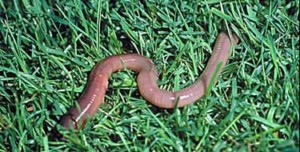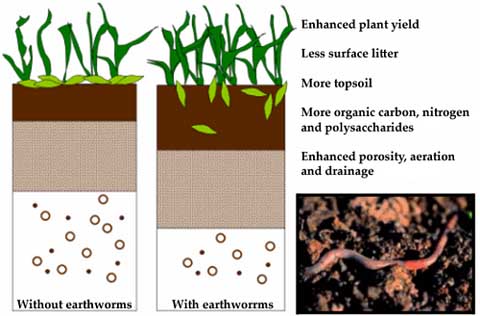 Nobody loves me, everybody hates me
Nobody loves me, everybody hates me
Think I’ll go and eat worms
Long ones, short ones, fat ones, thin ones
See how they wriggle and squirm
Wait! Don’t touch those beneficial worms! They are good for more than fish bait. I’m sure you have seen earthworms on the soil surface during and following rain storms. Many people think this happens because they are drowning as their soil tunnels become flooded, forcing them to higher ground. Actually, most earthworms can survive for several weeks under water as long as there is sufficient oxygen in the water to support them. They surface as a response to the high relative humidity after a rain because they can move around safely without drying out. Commonly, this is also the time when earthworms mate. Worms are hermaphrodites; each worm has both male and female organs. Another interesting tidbit is that they have the ability to re-grow portions of their body if the damage is not too significant. Earthworms fall into the category of freeze-avoiding invertebrates, meaning they will die if frozen. Some adult worms survive the winter by going below the frost line (42”) to hibernate. Earthworm “cocoons”, however are very tolerant to freezing and the worm eggs within survive over the winter to hatch in spring when conditions are right. In addition to fish bait, these creepy crawlers provide many benefits.
Did you know that they can:
- Improve the physical structure of the soil by creating channels which allow air, nutrients and water to enter the soil. This also improves soil aeration, porosity and permeability.
- Improve water filtration and absorption which help the soil drain better. Less runoff equals less watering and less erosion.
- Help compost existing chemical residues (fertilizers & pesticides). The bacteria in a worm’s gut can help destroy harmful chemicals and breakdown organic wastes.
- Create burrows that allow roots to easily go down deeper into the soil and get nutrients they could not ordinarily reach.
- Increase moisture absorption and the amount of moisture that is available to plants. Castings (worm excrement) absorb water faster than soil; castings hold more water than equivalent amounts of soil. They have the ability to absorb moisture from the air and hold it in a manner that plants can use.
- Improve soil fertility by bringing up minerals from deep in the subsurface that are often in short supply in surface layers. They aren’t adding new nutrients, but rather relocating existing nutrients. Earthworm activity counteracts leaching by bringing up nutrients from deep in the soil and depositing them on the soil’s surface as castings.
- Remove leaf and plant litter from the soil surface. Earthworms ingest the litter and leave the nutrients in their castings for plants to use as a natural fertilizer that is non-polluting.
- Make plant nutrients more available, worms concentrate minerals in their castings in a form that is easy for plants to absorb.
Did you know that earthworms are not native to this country? They were introduced by pioneers; some areas of the country don’t support earthworms because it is too cold.
Although earthworms help the soil’s structure, they don’t aid in its fertility. Earthworms digest and help decompose organic matter to release its constituent nutrients, but they don’t add to the nutrients. This is why adding organic matter in the form of compost or mulch is important. The beneficial effects of earthworms on plant growth are largely improved aeration and workability. The diagram shows the difference in organic matter with and without the presence of earthworms.
So there you have it. Those big fat juicy ones, and even those eensie weensy squeensy ones, are actually beneficial to your soil. Let them be, and happy gardening.
Useful links:
http://mypeoplepc.com/members/arbra/bbb/id19.html
http://www.managemyhome.com/mmh/articles/authored/the-benefits-of-earthworms

